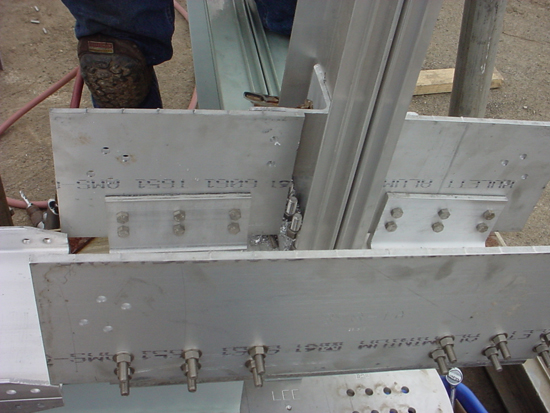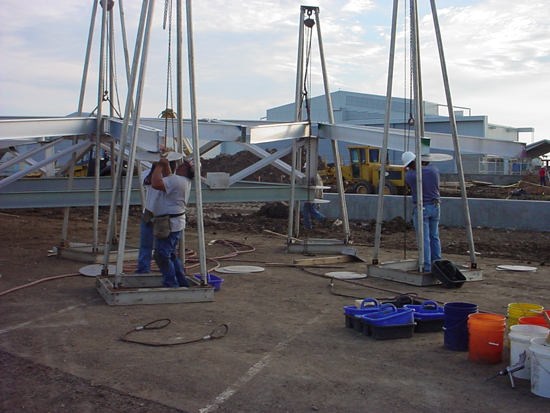Lightweighting With Aluminum: The Growing Trend for Architects Everywhere
Upcycling Sustainable Aluminum – Life-Cycle Benefits
Eager to add to the growing data on sustainable materials, in September 2011, the Aluminum Association published “Aluminum: The Element of Sustainability.” The industry’s sustainability group researched and documented their achievements in the changes that have occurred in the production of aluminum. Primarily, the industry is proud of its achievements in the reduction of energy demand associated with primary aluminum production by 17 percent and of secondary aluminum production by 58 percent. Aluminum is a material that can be continuously recycled. Unlike many other building materials, this recycling does not cause the material to lose its strength. Rather, aluminum can be continuously “upcycled” into new products.
Upcycling is a sustainable concept that first was addressed in the late nineties as a call for the reduction of the consumption and waste in most construction practices. “Upsizing” is a book by the German engineer, educator and ecologist, Johannes F. Hartkemeyer. His concept is that materials and product should be converted into materials with greater value rather than lesser value. Architect and authors William McDonough and Michael Braungart incorporated this concept in their influential book “Cradle to Cradle: Remaking the Way We Make Things.” It is also a concept that has been integrated into the life-cycle analysis of materials that architects choose for sustainable projects.
Although not yet a common practice, some architects are beginning to explore “Design for Disassembly” as part of their design strategy. A bolted frame using aluminum components can be designed for disassembly and reuse in future structures or upcycled to make new aluminum components.
Lifting Lightweight Aluminum – Constructability
Lightweight aluminum has numerous advantages during construction. From shipping to placement, a lighter material can save time, money and greenhouse gases. According to the U.S. Department of Energy, “Highway vehicles release about 1.7 billion tons of greenhouse gases (GHGs) into the atmosphere each year—mostly in the form of carbon dioxide (CO2)—contributing to global climate change.”v Since aluminum weighs 1/3 less than steel, the associated transportation cost of this lightweight material is reduced. Fewer trucks trips and fewer freight loads are used to provide this structural material for aluminum projects. The International Aluminum Association (IAA) provides data on the advantages of improving sustainability in the transport sector through weight reductions from the application of aluminum. These studies have been primarily focused on the reduction of weight in vehicles. According to the IAA: “The application of aluminum in passenger vehicles and light trucks manufactured in 2006 will lead to potential savings of approximately 140 million tons of CO2eq emissions and to energy savings of equivalent to 55 billion liters of crude oil over the life cycle of these vehicles. This is vital because the transport sector today generates about 19% of all manmade greenhouse gas emissions.”vi Weight reductions in both vehicle construction as well as reductions in the loads that they carry contribute to environmental savings. Specifying lightweight aluminum reduces transportation costs and the associated impact on the environment.
In the past, steel has been the “go-to” material for structural systems. Steel structural components are heavier by weight per pound of each component. Heavy, structural steel requires larger, stronger cranes and moving equipment. Most structural steel is welded in place requiring a greater reliance on skilled labor and field inspections. In comparison, lightweight aluminum can be assembled and erected even on difficult sites and locations. Fabricated components can be designed to minimize bolted connections for easy assembly while maximizing strength. Large structures can be engineered and fabricated in factory-controlled conditions and assembled without complex tools.
The impact of using a lightweight assembled frame versus a steel frame is seen in the example of the Lockheed-Martin Security Entrance Gate in Fort Worth, Texas. By using an aluminum system, the design team was able to save time, labor, equipment and transportation costs.
The Expansion of Lightweight Aluminum into Large Structural Systems
The use of aluminum as a structural material is expanding with technology and the continued advances of design. Some of this expansion can be related to the new forms of computer manufacturing. Some is related to new three-dimensional building information modeling which has allowed professionals to design new structures that have complex geometries. In many cases, these structures require unique, custom manufacturing. New integrated design teams include architects, structural engineers, manufacturers, material consultants and clients who all contribute information as part of the early phases of a design project. Their insights allow the designer to choose materials that from the beginning of a project complement their design strategy. Design professionals who want a thin profile for a metal building will choose aluminum over steel because of the material benefits of aluminum. From fabrication to assembly, larger, lighter structures have become possible, due to smart engineering and the design of efficient aluminum extrusions.
Most green rating systems provide credits for resource efficiency. Architects are choosing materials that provide reduced maintenance and replacement costs over the life of a building. Using materials that reduce transportation, the emission of harmful gases and those that are renewable and recyclable is a sustainable design strategy. According to the California Department of Resources Recycling and Recovery (CalRecycle), “Building and construction activities worldwide consume 3 billion tons of raw materials each year or 40 percent of total global use (Roodman and Lenssen, 1995). Using green building materials and products promotes conservation of dwindling non-renewable resources internationally. In addition, integrating green building materials into building projects can help reduce the environmental impacts associated with the extraction, transport, processing, fabrication, installation, reuse, recycling, and disposal of these building industry source materials.”vii CalRecycle recommends that the selection of a green building material be guided by numerous criteria. Among these are:
• “Recycled content: Products with identifiable recycled content, including post-industrial content with a preference for post-consumer content.
• Resource-efficient manufacturing process: Products manufactured with resource-efficient processes including reducing energy consumption, minimizing waste (recycled, recyclable and or source reduced product packaging), and reducing greenhouse gases.
• Reusable or recyclable: Select materials that can be easily dismantled and reused or recycled at the end of their useful life.
• Durable: Materials that are longer lasting or are comparable to conventional products with long life expectancies.”
Using these criteria as a guide for material selection, architects should carefully review the advantages of using lightweight aluminum in construction projects.

Photo courtesy of CST Covers
The structural members of extruded aluminum components are elegant, crisp, accurate and can be customized to meet any profile as seen in these edge conditions for the Lockheed-Martin Security Gate.
Responding to environmental goals, design professionals are minimizing the use of raw materials, specifying recycled materials and upcycling materials for use in new structures. Aluminum is recyclable and can contain recycled content to meet material goals for LEED® or other green building rating systems. The aluminum industry continues to expand the use of this durable material with a long life cycle into structural components. Lightweight aluminum is making some heavy statements for design professionals in the 21st century.
(www.celesteallennovakarchitect.com) specializes in sustainable design and planning in Ann Arbor, Michigan. She is the author of "Designing Rainwater Harvesting Systems: Integrating Rainwater Into Building Systems."
Endnotes
i http://sheetpileeurope.ch/uploads/CMI technische documenten (engels)/aluminum_corrosion.pdf
ii IBID
iii Latest Sustainability Accomplishments. http://www.sustainablecitiesinstitute.org/cities/salt-lake-city-utah September 15, 2014.
iv The Climate Registry. http://www.theclimateregistry.org/ September 15, 2014
v Reduce Climate Change. http://www.fueleconomy.gov/feg/climate.shtml. September 17, 2014
vi https://www.alcoa.com/global/en/environment/pdf/GTS_paper_final.pdf. September 23, 2014
vii http://www.calrecycle.ca.gov/greenbuilding/materials, September 23, 2014
 |
CST Covers is a global design/build firm with expertise in high-strength aluminum signature solutions such as spaceframes, domes, environmental enclosures, canopies, large span, and specialty lightweight structures designed for unique eco-friendly vertical and overhead applications. www.cstcovers.com |











